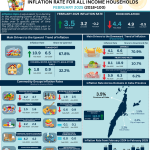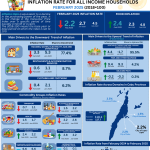1. Philippines
In February 2023, the headline inflation in the Philippines slowed down to 8.6 percent, from 8.7 percent in January 2023. This is lower by 0.1 percent from the previous month’s record. The average inflation rate for the first two months of 2023 stood at 8.6 percent. In February 2022, the Philippines’ average inflation was lower at 3.0 percent. (Table A)
The downtrend of inflation in February 2023 was solely due to the lower annual rate of transport recording at 9.0 percent inflation from the 11.1 percent inflation in January 2023. Contrary, nine commodity groups at the national level showed higher inflation rates and two commodity groups moved from the previous month’s record. Meanwhile, financial service index remained to record at zero percent annual rate.
2. Central Visayas
Unlike at the national level, inflation in Central Visayas’ accelerated to 7.4 percent in February 2023 from 7.2 percent record in January 2023. This is higher by 0.2 percent from that of January’s record of inflation. In February 2022, the region’s average inflation was lower at 5.1 percent. The average inflation of all provinces in the region also moved at 7.3 percent in February 2023.
Among provinces, the Province of Siquijor recorded the highest inflation at 12.1 percent which is also the highest recorded increase rate of inflation in February 2023 followed by the Province of Bohol at 9.4 percent while the Province of Cebu posted the lower inflation in February 2023 at 7.5 percent. (Table A)
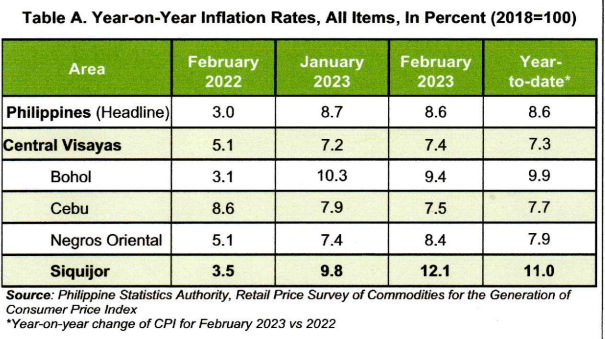
3. Province of Siquijor
Following the uptick of inflation at the regional level, the inflation at the province hiked at 12.1 percent. This month’s rate of inflation increased by 2.3 percent from its previous month’s record of 9.8 percent. This was the highest recorded inflation in the province since January of 2019. In February 2022, Siquijor’s average inflation stood at 11.0 percent. (Table A & B and Figure 1)
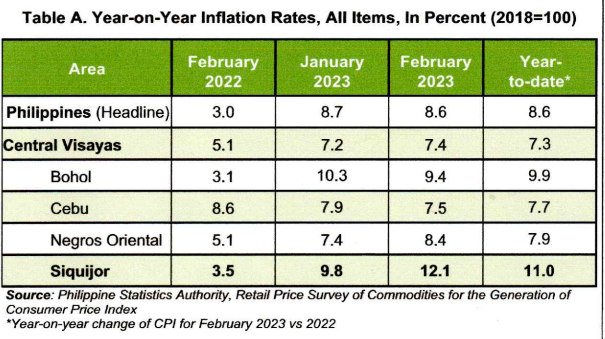
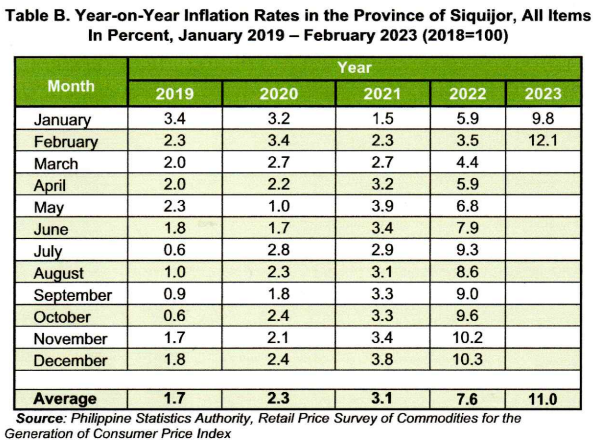
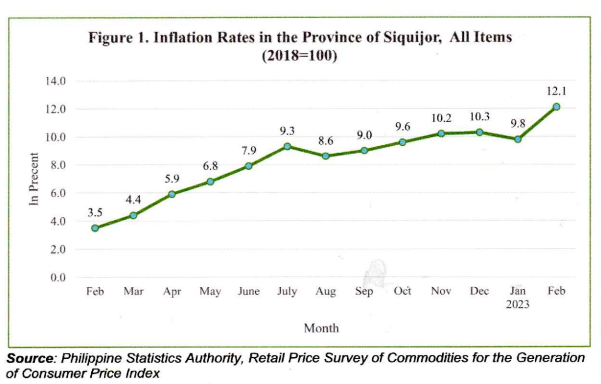
The uptick of inflation in the province were mainly due to the higher annual rate in the index of food and non-alcoholic beverages from 10.6 percent in January 2023 to 15.6 percent in February 2023, alcoholic beverages and tobacco from 8.0 percent in January 2023 to 9.5 percent in February 2023 and transport from 13.9 percent in January 2023 to 14.2 percent in February 2023. (Table 3 and 4)
Moreover, indices of the following commodity groups recorded higher annual inflation rate in February 2023:
clothing and footwear, 9.8 percent;
personal care, miscellaneous goods and services, 5.6 percent;
health, 3.6 percent;
furnishings, household equipment and routine household maintenance, 17.6 percent; and
recreation, sport and culture, 3.7 percent. (Table 3 and 4)
Meanwhile, indices of housing, water, electricity, gas and other fuels; information and communication; education services; restaurant and accommodation services; and financial services remained at their previous month’s rates. (Table 3 and 4)
Food Inflation at the provincial level hiked in February 2023 from 10.7 percent in January 2023 to 16.0 percent. The higher inflation rate of food index of the province was mainly due to rise in the indices of fish and other seafood from 3.0 percent in January 2023 to 19.2 percent in February 2023, and vegetables, tubers, plantains, cooking bananas and pulses from 17.4 percent in January 2023 to 26.1 percent in February 2023. (Table 5 & 9)
Meanwhile, higher annual growth rates of indices were also observed in the following food groups:
Milk, other dairy products and eggs, 8.7 percent;
Meat and other parts of slaughtered land animals, 22.5 percent;
Ready-made food and other food products n.e.c., 8.7 percent; and
Cereals and cereal products, 9.2 percent; and
Oils and fats, 11.8 percent. (Table 5 & 9)
On the other hand, indices in fruits and nuts, and sugar, confectionary and desserts slowed down in the February 2023. Inflation rate for fruits and nuts moved from 17.3 percent in January 2023 to 15.8 percent in February 2023 while sugar, confectionary and desserts moved from 40.0 percent in January 2023 to 39.2 percent in February 2023. (Table 5 & 9)
Indices under cereals and cereal products food group also showed an increase from the previous month’s record. Cereals increased from to 9.0 percent in January 2023 to 10.4 percent in February 2023 while flour, bread and other bakery products, pasta products, and other cereals declined from 6.0 percent in January 2023 to 5.2 percent in February 2023. (Table 5 & 9)
For cereals food group, index for rice posted a higher increase in this month from 8.6 percent in January 2023 to 10.4 percent which was also one of the major contributors of the uptick of food inflation at the provincial level while index for corn rose further from 9.8 percent in January 2023 to 10.4 percent in February 2023. (Table 5 & 9)
TECHNICAL NOTES
Consumer Price Index (CPI)
The CPI is an indicator of the change in the average retail prices of a fixed basket of goods and services commonly purchased by households relative to a base year.
Uses of CPI
The CPI is most widely used in the calculation of the inflation rate and purchasing power of peso. It is a major statistical series used for economic analysis and as monitoring indicator of the government economic policy.
Measures the composite change in the consumer prices in various commodities overtime.
Computation of CPI
The computation of CPI involves consideration of the following important points:
a. Base Period – The reference date or base period is the benchmark or reference date or period at which the index is taken as equal to 100.
b. Market Basket – A sample of the thousands of varieties of goods purchased for consumption and the services availed by the households in the country selected to represent the composite price behavior of all goods and services purchased by consumers.
c. Weighting System – The weighting pattern uses the expenditures on various consumer items purchased by households as a proportion to total expenditure.
d. Formula – The formula used in computing the CPI is the weighted arithmetic mean of price relatives, the Laspeyre’s formula with a fixed base year period (2018) weights.
e. Geographic Coverage – CPI values are computed at the national, regional, and provincial levels, and or selected cities.
Inflation Rate
The inflation rate is the annual rate of change or the year-on-year change of CPI expressed in percent. Inflation is interpreted in terms of declining purchasing power of money.
***Statistical tables in excel file are provided as an attachment of this release.
(SGD.) JOSELITO C. MAGHANOY
(Supervising Statistical Specialist)
Officer-in-Charge


